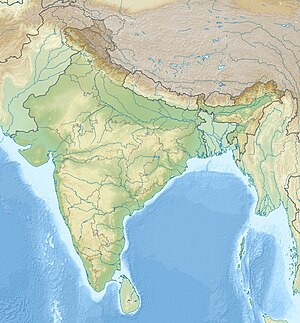
Back Fortalesa de Gwalior Catalan Gválijarská pevnost Czech Κάστρο του Γκουάλιορ Greek Fortaleza de Gwalior Spanish Gwalior gotorlekua EU Fort de Gwalior French ग्वालियर का क़िला HI Forte di Gwalior Italian グワーリヤル城 Japanese ಗ್ವಾಲಿಯರ್ ಕೋಟೆ KN
This article's factual accuracy is disputed. (May 2024) |
| Fort of Gwalior | |
|---|---|
| Madhya Pradesh, India | |
 The "Man Mandir" palace built by Tomar Rajput ruler Man Singh Tomar (reigned 1486–1516 CE), at Gwalior Fort | |
| Coordinates | 26°13′49″N 78°10′08″E / 26.2303°N 78.1689°E |
| Type | Fort |
| Site information | |
| Owner |
|
| Open to the public | Yes |
| Site history | |
| Built | 6th century, The modern-day fort, consisting a defensive structure and two palaces was built by King Man Singh Tomar,[1] later renovated by Scindias under the Supervision of General Sardar Surve in 1916 |
| In use | Yes |
| Materials | Sandstone and lime mortar |
| Battles/wars | Numerous |
| Events | Numerous |
The Fort of Gwalior or the Gwalior Fort is a defence hill fort in Gwalior, India. Mughal Emperor Babur called it the "pearl amongst the fortresses of Hind" because of its impregnability and magnificence and it has also been nicknamed the Gibraltar of India.[2] The history of the fort goes back to the 5th century or perhaps to a period still earlier. The old name of the hill as recorded in ancient Sanskrit inscriptions is Gopgiri.[3] The current structure of the fort has existed at least since the 8th century, and the inscriptions and monuments found within what is now the fort campus indicate that it may have existed as early as the beginning of the 6th century, making it one of India's oldest defence fort still in existence. The modern-day fort, embodying a defensive structure and two palaces was built by the Tomar Rajput ruler Man Singh Tomar (reigned 1486–1516 CE).[1][4] It has witnessed the varying fortunes of the Guptas, the Hunas, the Pratiharas, the Kachhwahas, the Tomaras, the Pathans, the Surs, the Mughals, the English, the Jats, and the Marathas represented by the powerful Scindia dynasty who have left their landmarks in the various monuments which are still preserved.
The present-day fort consists of a defensive structure and two main palaces, "Man Mandir" and Gujari Mahal, built by Man Singh Tomar, the latter one for his Gurjar wife, Queen Mrignayani.[1] The second oldest record of "zero" in the world was found in a small temple (the stone inscription has the second oldest record of the numeric zero symbol having a place value as in the modern decimal notation), which is located on the way to the top. The inscription is around 1500 years old.[5][6]
- ^ a b c d Paul E. Schellinger & Robert M. Salkin 1994, p. 312.
- ^ "Gibraltar of India". 19 March 2022.
- ^ "Gwalior Monument". Archaeological Survey of India Bhopal.
- ^ Romila Thapar (2003). The Penguin History of Early India: From the Origins to AD 1300. Penguin Books Limited. p. 179. ISBN 978-0-14-193742-7.
Other claiming to be Rajput and descent from Solar and lunar lines established themselves as local kings in Western and Central India. Among these were the Chandelas present in 12th century in Bundelkhand, the Tomaras also subject to the earlier Pratiharas ruling in Haryana region near Dhilaka, now Delhi, around 736 AD and later established themselves in Gwalior region
- ^ You Can Visit the World's Oldest Zero at a Temple in India Archived 16 September 2017 at the Wayback Machine, Smithsonian magazine.
- ^ Joseph, George Gheverghese (2016). Indian Mathematics: Engaging with the World from Ancient to Modern Times. World Scientific. ISBN 978-1786340634.
In a temple on the path up to Gwalior Fort [...] where we find a circular zero in the terminal position.
[page needed]

